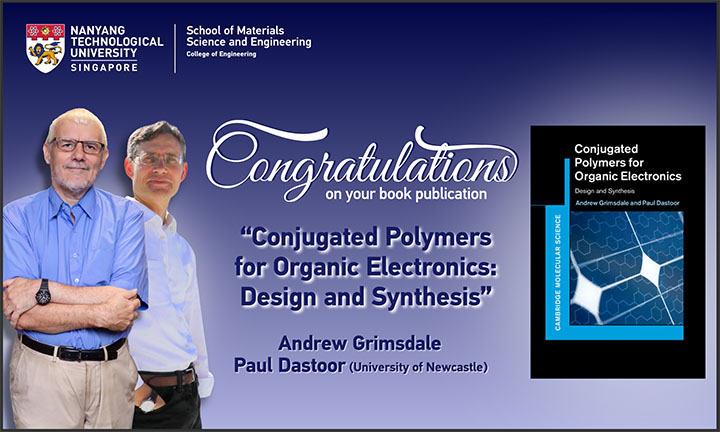Book Publication by Associate Professor Andrew Grimsdale: "Conjugated Polymers for Organic Electronics: Design and Synthesis"
We are thrilled to share that Associate Professor Andrew Grimsdale, in collaboration with Professor Paul Dastoor (University of Newcastle), has published a book titled "Conjugated Polymers for Organic Electronics: Design and Synthesis".

As part of the Cambridge Molecular Science series by Cambridge University Press, the book serves as a comprehensive guide for researchers and practitioners alike. It offers deep insights into the design, synthesis, and application of conjugated polymers
in organic electronic devices. It also provides a detailed exploration of the chemistry and physics behind conjugated polymers and their role in developing sustainable electronic devices.
Highlights of The Book:
- Interdisciplinary Approach to Innovation: The book vividly illustrates interdisciplinary science by describing how chemists and physicists collaborate to harness high-performance materials for the development of commercially viable polymer-based
electronic devices.
- Comprehensive Introduction to Conjugated Polymers: The book encompasses the main classes of conjugated polymers, detailing their synthesis, properties, and categorisation – essential knowledge for steering future innovation in the
field of organic electronics.
- Applications in Organic Electronic Devices: From transistors and light-emitting diodes to solar cells, the book evaluates the application of conjugated polymers in various devices, examining how their design and synthesis optimise device
performance.
- Synthesis & Optimisation For Enhanced Performance: The book offers a deep dive into methodologies for making conjugated polymers and the structural attributes that elevate their utility. It is a treasure trove of insights for developing efficient devices.
Behind The Book:
Associate Professor Andrew Grimsdale has over thirty years of experience in synthesising materials for organic electronics. His work is widely cited, positioning him as a leading authority in luminescent polymers. His motivation for writing
the book stemmed from the absence of a comprehensive resource for newcomers in the field of organic electronics. The book aims to fill that gap, offering foundational knowledge and forward-thinking strategies for developing high-performance organic
electronic devices. Associate Professor Grimsdale hopes the book will serve as a valuable resource and inspire readers to think critically when designing materials for specific applications, considering factors such as impurities and their effects
on device performance.
Professor Paul Dastoor (University of Newcastle) is renowned for his contributions to organic electronic devices, particularly in the development of printed solar and biosensor technology. His track record in research commercialisation
has led to the formation of several spin-off companies, marking significant milestones in the field. Professor Dastoor brings a crucial physicist’s perspective that enriches the book with insights into device performance and specific application
considerations. Their collaborative effort underscores a critical realisation – the advancement of organic electronics hinges on the seamless integration of chemistry and physics. Real-world examples, such as the story on the unwanted yellow/green
emission from blue-emitting polymers e.g. polyfluorenes and how it was overcome, illustrate the need for interdisciplinary collaboration in overcoming the challenges associated with material design and device fabrication.
We extend our heartfelt congratulations to Associate Professor Andrew Grimsdale and Professor Paul Dastoor on this outstanding achievement! Their dedication and expertise have culminated in a book that will undoubtedly make a significant impact on the
scientific community.
Related Links:







